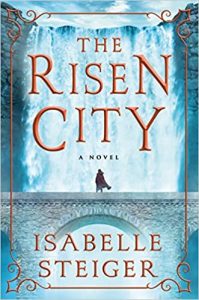Isabelle Steiger: Growing up in the Woods
 Until I was eight years old, my brother’s and my idea of after-school excitement was a trip to the arcade. That summer, our parents moved us from Manhattan to about an hour upstate—“the suburbs,” I told my friends back in New York, because I didn’t have a firm grasp of what the suburbs were, other than “not the city.” But anyone who ever visited me soon set me straight: I now lived in the country. Or, to those who were less charitable, I lived in the middle of nowhere.
Until I was eight years old, my brother’s and my idea of after-school excitement was a trip to the arcade. That summer, our parents moved us from Manhattan to about an hour upstate—“the suburbs,” I told my friends back in New York, because I didn’t have a firm grasp of what the suburbs were, other than “not the city.” But anyone who ever visited me soon set me straight: I now lived in the country. Or, to those who were less charitable, I lived in the middle of nowhere.
It definitely seemed that way to me, especially at first. Our “new” house was ancient, in need of drastic repairs—my bedroom wasn’t yet habitable when we moved in—and perched all alone on top of a hill, a frequent target of lightning strikes that had about a fifty-fifty chance of knocking out our power or internet. Forget walking to the arcade; it took fifteen minutes just to walk to our mailbox. The closest movie theater and bookstore were a half-hour drive on a good traffic day; the sole entertainment opportunity that could even generously be called local was a roadside ice cream spot (which, to be fair, sold the best soft-serve I’ve had to this day). I couldn’t understand what had possessed my parents to exchange this place for the city, where everything I could conceivably want seemed at my fingertips.
But my mother wanted a garden, and nothing could deter her enthusiasm for it, not even a snip to her knuckles while she was pruning stems that sent her to the emergency room. She created an elegant sweep of manicured lawn ringed by flowerbeds—beautiful, but it bored me and my brother after half a day. What drew our attention was the stone wall surrounding the garden, that dropped on one side to about shin height, easy to walk right over. And on the other side of it, there was just… the woods.
It wasn’t as if we’d never seen grass and trees before. Back in the city, we’d gone to Central Park every weekend, and we vacationed upstate during the summer. But the woods, for us, weren’t about trees, they were about what wasn’t there: fences, walls, boundaries of any kind. Our attempts to probe their limits came up laughably short; my friend Natalie and I once set out on a new path we’d discovered, determined to follow it until it took us somewhere, and turned back in exhaustion more than an hour later, the path still stretching ahead of us into seemingly interminable forest.
Thanks to The Boxcar Children and The Chronicles of Narnia, forests already featured heavily in my imagination, but they were vague, overembellished things, inspired by the idea of a place in opposition to the city where I was born. A place bursting with and belonging to wildlife, where humans and their creations could only be alien. Our forest was as vast as I’d imagined, but quieter, lonelier, more secretive. Our area was known to be devoid of predators, so much so that we had a massive overpopulation of deer, archnemeses to my mother and her garden. But they and all the other animals must have been able to hear me and my brother galumphing through dead leaves from miles away; for all our ranging, we’d be lucky to see a bird or a squirrel. Most of the time, we explored in solitude, and our most fascinating discoveries had much more to do with the people who’d come before us than with nature.
We found the remains of an outdoor tennis court, nearly covered by fallen leaves. Not far away was a rocky hill topped by benches and a little table made of slabs of stone—an abandoned picnic spot, or a vantage point from which spectators had once watched matches? Just off one side of the winding road that led up the hill to our house, my brother found another track, narrow and unpaved, that might have been in use before cars and asphalt. And my favorite discovery of all stood solitary in a little field: a towering stone chimney, with stone steps a few feet away from it, leading to nothing. According to my mother, it was all that remained of a log cabin: fire had destroyed the wood, leaving behind only the parts that wouldn’t burn. We turned them into landmarks on the map of our adventures—consolation, perhaps, for knowing we’d never get the full truth. For every secret the forest surrendered, countless more lay beyond our reach.
Ten years after moving to the woods, I came back to the city. It’s been a long time since I brought my notebook with me up a hillside instead of to a diner, or cleared my head with a walk among the trees the day after a rain. Writing fantasy lets you make up as many locations as you want, and I think my love for cities is evident in all the ones I’ve created. But I created Esthrades, too: a country covered in a forest its people know to revere, studded with ruins made strange and obscure by time, the way a stairway to nowhere posed a riddle to two young children. Even its capital city was once only a spire upon a hill, a tower of stone planted in my imagination by the remains of that log cabin. I found a way to bring a piece of the woods that so fascinated me into the cities of my dreams—a fitting compromise for one who wandered through them both.
—
Isabelle Steiger was born in the city and grew up in the woods. She received her first notebook when she was eight, and she’s been filling them up ever since. When not writing, she enjoys playing RPGs, getting excited over obscure facts, and never knowing enough about movies to sound cool when she talks about them. She is only fluent in one language but can speak three others terribly, and is possibly the only person who hates sand as much as Anakin Skywalker. After a childhood filled with haunted mansions, lightning-induced power outages, and insects rude enough to sabotage a perfectly honorable swordfight, she was relieved to finally return to New York, where she currently lives. The Empire’s Ghost is her first novel.
Find out more about Isabelle on her website https://www.isabellesteiger.com/
Follow her on Twitter https://twitter.com/steigia
THE RISEN CITY
BUY HERE
Category: On Writing

 The powerful finale of the Paths of Lantistyne series, which returns us to a continent in the midst of an epic battle for salvation.
The powerful finale of the Paths of Lantistyne series, which returns us to a continent in the midst of an epic battle for salvation.






















